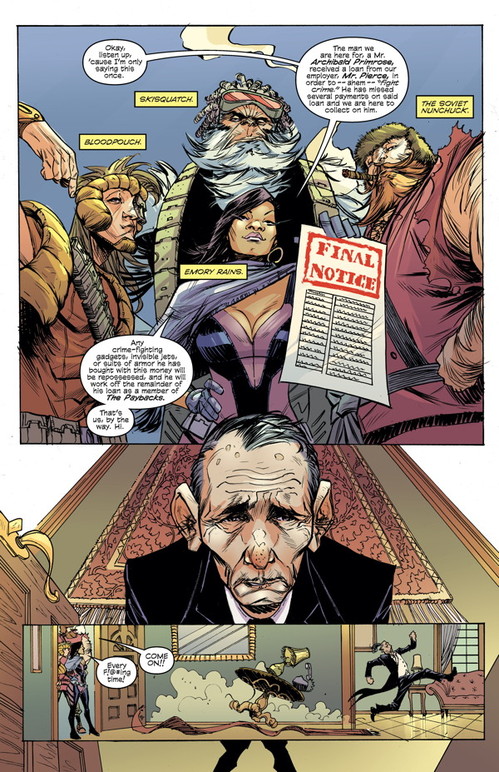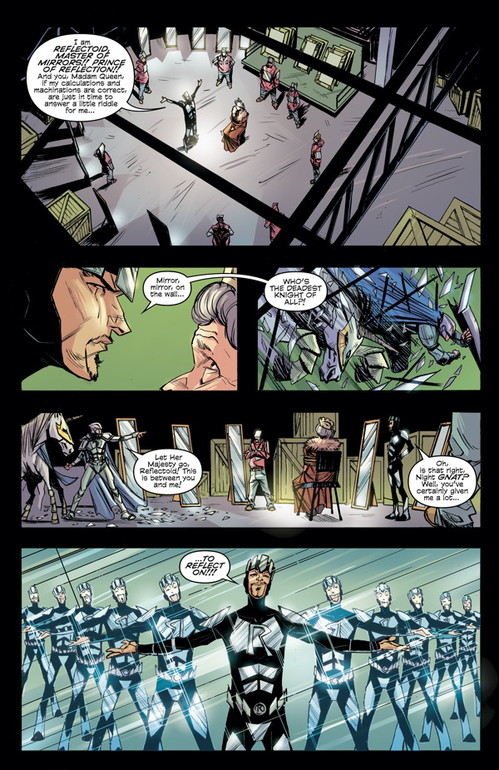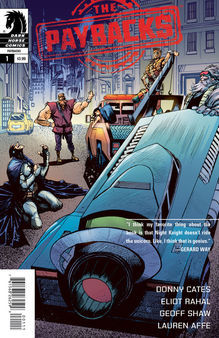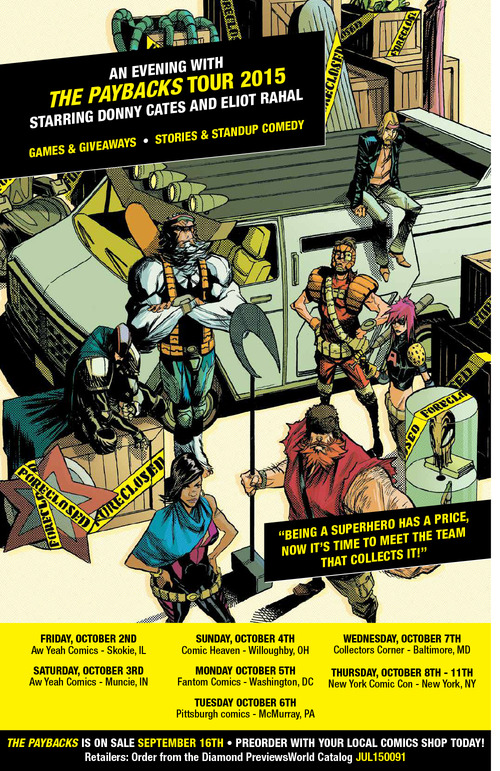“These are characters who have failed”: Donny Cates & Eliot Rahal on the Debt-Addled Superheroes of The Paybacks
Comics Features Donny CatesWhat happens when you can’t afford to refuel the Batmobile? Default on a Danger Room payment? Fail to pay interest on your Fortress of Solitude mortgage loan? Get ready to face the Paybacks, a team of down and out heroes working repo to wash away the debts they accrued while trying to make it big in the do-gooder scene.
Written by Donny Cates and Eliot Rahal and drawn by Cates’s Buzzkill collaborator Geoff Shaw, The Paybacks is far more than a Brat Pack-esque dark parody of superhero tropes. Much like Buzzkill before it, The Paybacks balances its high concept spin (the crushing reality of debt and failure) with a genuine love for superheroes both wildly original and fresh out of a Captain Ersatz mold. The first issue of this Dark Horse ongoing series bursts at the seams with quirky characters, off-the-wall concepts and rewarding Easter eggs for readers with a dedicated “Where’s Waldo?” eye for crowd scenes.
![]()
Paste chatted with longtime pals and creative partners Cates and Rahal to talk about handling the book’s depressing themes, toeing the line between parody and affection and the lack of superhero bathroom breaks in mainstream comics.
Paste: With The Paybacks, you’re tackling debt collection through a super-powered lens. Buzzkill had a similar relationship with addiction. What’s the appeal of approaching these mundane, even depressing subjects with a superhero angle?
Donny Cates: When I co-wrote Buzzkill with Mark Reznicek, the drummer for The Toadies, that’s something we talked about a lot because the story of a guy who gets powers from drinking and doing drugs is something that could have been a joke, and that’s not the way we wanted to approach it at all. We wanted to really be able to talk about the subject in a way that would help it go down easier. Putting it through that reliable, kind of staid trope of superheroes allowed us to talk about things without making it too heavy. And doing that with debt just seemed like a natural extension. In fact, The Paybacks is something Eliot and I had been talking about before Buzzkill was even written. And after Buzzkill did fairly well, we were talking about how we already had this whole superhero world waiting to be explored. It was just a natural fit, thematically, to explore that same kind of dichotomy.

The Paybacks Interior Art by Geoff Shaw
Eliot Rahal: Buzzkill and The Paybacks deal with these power structures either emotionally or bureaucratically or financially, in some way as a sort of background. Those big subjects are very important parts of the book, but they help drive the story and our story is about the characters. Buzzkill is a story about Ruben and his struggle, and yeah, his struggle is drinking and addiction. The Paybacks is about indebted superheroes, but it’s also about them trying to find each other, and about how they deal with this situation. They’re heroes first and foremost, and they’re heroes who failed, and that sucks for them real hard. Donny likes to say they’re in their third acts. When we meet them, it didn’t work out. They are the scrubs. They’re broken people and they’re kind of all dealing with that.
Cates: The comparison we always draw is that Buzzkill was Breaking Bad, and this is Better Call Saul. Meaning that Buzzkill was really intense and really heavy at points—it was aptly named—but this, besides the trappings of talking about debt and the burdens of that, really comes from a place of two best friends wanting to create a whole big superhero world that they can go play in. Why wait for anyone else to let us play in their sandbox, let’s just go build our own.
Rahal: Dark Horse is giving us so much room. We can do kind of whatever we want, and I think that’s why you see a lot of, for lack of a better term, weird shit in there, because we like to think about it like we got away with something.
Cates: Every script that we turn in, every time we get a new page from Geoff [Shaw], we just constantly call each other and say, “Can you believe they’re letting us do this? When are they going to find out that we’re just playing?”
Rahal: It’s fun, and I think sometimes we amp it up even more because we’re so afraid they’re going to catch on. They’re going to figure out we have a unicorn in this book. [Laughs]
Paste: Artist Geoff Shaw and colorist Lauren Affe are also back from Buzzkill. Can you talk a bit about what they bring to the project?
Cates: Geoff and Lauren and I were all students together at SCAD, the Savannah College of Art and Design. I always loved Geoff’s work in class and I was crazy, crazy fortunate to get him to come onto Buzzkill. I think after the last book, Dark Horse kind of wanted me to do a sequel. If you haven’t read that story yet, I’ll just say this: it would be very difficult to do a sequel to it. [Laughs] When we decided to go with this idea, making this the spiritual sequel with a different topic, getting Geoff on board really makes everything pop. Geoff has such a perfect balance of humor and action, and there’s nothing that he can’t draw, which gets him in trouble a lot. Now that we know that he can draw anything, we are throwing out the most ridiculous stuff and he just nails it every single time.
Rahal: I think the thing that I love most about working with Geoff is that yeah, we can give him direction and yeah, we can give him crazy things to draw, but his art is a collaboration with us. He reads the story that we give him and he expands on it with subtle details that even Donny and I aren’t aware of. We’re trying to build a universe within Dark Horse, we’re trying to make this a real place where readers feel a legacy of characters that they can attach to, and Geoff understands that. We incorporate his art into our writing, and it’s a really nice, mutually fun collaborative process that’s, not to be lame, a real treat! [Laughs]
Cates: We work ahead, so as of right now, Geoff is drawing issue seven and Eliot and I are finishing issues 11 and 12. Because we get to work so far in advance, there are little cool things we can do with Geoff. In the first issue, there’s that double-page spread where you see hundreds of little super people. For the most part, in our script, we just told him to have fun, and now what we get to do is pull characters out of that spread and give them names and stories. I think in season two, which is what we’re calling issues 13 to 24, you’re going to start seeing a lot of those characters pop up as main cast members. Eliot and I are, at the core of this book, two kids playing with our toys, and Geoff brings all these cool toys to play with.

The Paybacks Interior Art by Geoff Shaw
Rahal: And Lauren’s colors, I think, just complete the entire process. She literally brings color to our world.
Cates: She makes coloring choices that you would never think of in a million years, and I don’t think we’ve ever given her a single note. We’ve been working with her for five years. I’ve actually never done a book without her on it. She does stuff that, were you to write it down on paper like, “Okay, the sky’s going to be purple, the smoke coming out of this guy’s gun is going to be green…” you’d be like, What? That’s weird, but it comes in and you’ve never seen anything like it and it’s always perfect. She has this amazing lens she sees things through, so trying to give her a note would just be a waste of time.
Paste: Your cast is huge and pretty eclectic, but you use variations on stock characters to really effective ends. It’s clear who Night Knight is evoking, for instance. As writers, how do you effectively use these archetypal cape characters without falling too far into parody?
Rahal: This book toes a lot of lines. When we’re thinking about superheroes, you have your Supermans, like Highguard from Buzzkill—you have these people who are “big time” and have made it. But there are a lot of superhero books. What’s the difference between this great detective and that great detective? We get to play with that because there is a lot of redundancy in regular superhero books. With regards to parody, yeah, what we’re doing is often obvious, but we focus on making those parodies actual characters and making them real people with flaws. Night Knight is such a flamboyant person. He’s so narcissistic and into himself. You see things that are reflective of other superhero books, to draw the reader in, to give the reader familiarity, but we don’t want to rely on that without having it turn into something else.
Cates: This is something we’ve said prior, but this is in no way a commentary on comics. It’s not really meant to be a parody. We don’t have a replacement Batman because we can’t use Batman. We have characters who have a similar look or a similar story, but that’s on purpose. Like Rahal was trying to say, these are characters who have failed. It’s not always going to work out because the world already has a Batman, Night Knight, so your shtick isn’t going to work. There are already non-powered people with dead parents, so this isn’t going to work out for you, dude. What I love about having these superhero tropes in there is that it cuts down on the time that you need to explain stuff. As soon as you see Night Knight, we’re using that language to talk to our audience. They know what’s going on. And when you see our big Justice League/Avengers-type super-team, they’re on a moon base, and we don’t need to explain to you what they are. That kind of shorthand really helps get to the meat of the story.
Rahal: And jumping off of that, the reason I think you see all of this stuff is that we both just love comics. It’s not a parody, it’s a loving tribute. We have some direct, fun references to ‘90s comic books that aren’t a parody, we just think it’s cool.
Paste: For any number of reasons, not too many creators are introducing their own capes and tights characters these days. What keeps you invested in the superhero genre? Do any non-Big Two superhero books stand out as particular inspirations on the way you approach The Paybacks?
Cates: Beside the virtue of just having read comics since we were children, as far as archetypes go? No, not really. Obviously there are characters we really like that are an homage to an era, but I could probably answer that better if I was writing it by myself. By virtue of writing it with Eliot, the main influence for it for me, is him.
Rahal: And vice versa.
Cates: The ideas that come into the book, it’s never like, “Hey, let’s talk about the Dark Phoenix Saga and do our own version.” It’s always, “Let’s get on the phone with your best buddy and come up with cool superheroes and see what they can do.” And what’s fun about it is that you’re not seeing us try to come up with the coolest, dopest heroes. What we try to do is come up with heroes who would fail. That’s the whole point of this book. If we had a hero who was really awesome and powerful, why would they be on the Paybacks? Why would they be working? So you’re seeing us actively try to come up with characters who could not stand alone in their own book.

The Paybacks Interior Art by Geoff Shaw
Rahal: But who, at the same time, aren’t jokes or silly or stupid, like, “Oh, he’s got the power to make spaghetti,” nothing dumb like that.
Cates: That’s a hard line to follow, too, because you want the characters themselves to think that they are awesome.
Rahal: Because they had to have that moment in their salad years when they were like, I’m going to be a hero because I am special. In order to believe that, there has to be some part of that that is true. If you’re an outright joke, I’d like to think everyone has enough self-awareness to be like, Maybe I shouldn’t do this…
Cates: These are characters that have been in our heads for a while. I like to think, and time will tell on this, that we’re doing stuff in this book that I’ve never seen superhero books do. And I don’t mean that we’re going to try to out-explosion them or anything. I’m talking about quiet character things. I think we have a scene where a character goes to the bathroom. When do you ever see that? [Laughs]
Rahal: That’s something that has always bothered me. It’s like, “X-Men, let’s go, we’re going to go get Magneto right now!” And no one is like—
Cates: “Gotta go to the little boys room!”
Rahal: That absolutely happens!
Cates: We don’t mean that in a crass way. We were interviewed a month or so back, and someone said—and we had never even thought of this—that we tend to write “working class comics.” We really enjoy Big Two comics for sure, but just due to their very existence, they don’t get to spend much time in the mundane day-to-day. Just by the premise of this book, that’s almost all that’s going to happen. Not that there’s not crazy stuff happening, but these characters are at work every day. As you’ll see, something horrible will go wrong, and it’s not like the X-Men where in the next issue they’re going to go and get their retaliation. No, in the next issue they have a new target, they have a new job. The higher-ups will handle that, but you guys have to go work or you don’t get to live anymore. I think that’s interesting as a team dynamic for the Charles Xavier character to actively not care about you.
Rahal: There are consequences. And that’s something I’m excited about for readers to see. If somebody gets hurt, they’re going to stay hurt. They’re not just going to be fine right away.
Cates: The entire book is a consequence, from the very first page.
Paste: Speaking of the first page, your first issue starts with a who’s who introducing the large cast but, without spoiling anything, not everyone on that list survives the first 20 pages. Is the cast we meet locked in, or is this a no-one-is-safe situation?
Cates: No one is safe. Absolutely. And that’s not a choice we made to be shocking or anything, it really just came out of the rules of this book. It only makes sense. If you’re going to be going into the Batcave or the X-Men’s Danger Room to take stuff, it’s going to go bad. It’s going to go bad a lot. There’s something Eliot wrote that I’m going to steal from him: There are only two ways off of the Paybacks. One way is you do enough work and you pay off your debt. The other one is in a body bag, and one of those things happens way more than the other.
Rahal: By nature of the Paybacks and who is in this group, they’re generally B- and C-listers. There’s not a heavy hitter there unless something really weird happened to that person. You put enough of those people up against A-listers or even other C- or B-listers, they’re evenly matched or outclassed every time. Repo is a dangerous job. That being said, the cast that you meet on the first page is our starting cast, and we want you to become familiar with them, so we can hurt you later. [Laughs]

The Paybacks Interior Art by Geoff Shaw
Paste: Did anyone start out as cannon fodder but worm their way into your hearts?
Cates: No comment. [Laughs] Keep reading! I will say this, as a blanket statement, I think maybe every character started off as us joking with each other, Oh, this would be a funny name for a guy. This would be a cool story for a guy. But Eliot and I are such sensitive, lame dudes, I am emotionally attached to every single person in this book in a big, bad way. There are some characters that we had a plan for, that was maybe not the greatest plan for that character, and we may have changed our minds because we love them so much. That being said, we have a rule amongst ourselves: if it comes up in a script that, Hey, you know what should probably happen here? This guy or girl should not make it out. If it hurts our feelings to say that, they’re gone. Because we know that’s going to affect the reader that much more.
Paste: Any final words on The Paybacks before the first issue hits shelves?
Rahal: Uhm, just buy it.
Cates: People have asked how long this book is going to go, and my flippant response to that is always that I’m using the money I make off of this book to pay off my student loans, so it’ll be going on for like 88 years or so. [Laughs] The real response though is that it’s up to you guys. We are forging ahead. We have big, big plans. We already have seasons two, three and four planned out.
Rahal: We’re doing everything we can to shove this down everyone’s faces.
Cates: Which includes a tour. Starting in early October, we’re doing a signing tour from Chicago to New York Comic-Con, hitting a comic book store every day for seven or eight days. It’s called “An Evening with the Paybacks” and it’s more than just a signing. We’ll do a signing during the day and at night it’s a variety show, because my man here is a stand-up comic and a great one at that, and he is going to be bringing local talent on stage. I’m going to host, and we’re going to have sketches and prizes and trivia. We’re bringing buttons and temporary tattoos and all kinds of stuff. It’s going to be a lot of fun.

